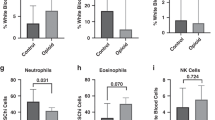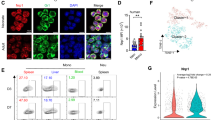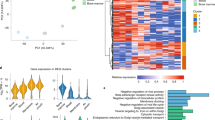Abstract
Neonatal neutrophils have Mac-1-related functional abnormalities that may contribute to the enhanced susceptibility of neonates to bacterial infections. We developed a flow cytometric method using differences in light scattering and CD16 expression to distinguish eosinophils from neutrophils and studied their responses to stimulation in vitro. Mean forward light scatter was 20–60% greater for adult neutrophils than eosinophils, p ≤ 0.001, and side scatter was 30–60% greater for eosinophils than neutrophils, p ≤ 0.01, both before and after stimulation. Light scatter of neonatal and adult eosinophils did not differ. Mac-1 expression on adult eosinophils increased 60% after warming without specific stimulation and further increased 5-fold after incubation with 1 μM A23187, p < 0.0001. Platelet activating factor and recombinant C5a produced modest increases in eosinophil Mac-1 expression, while N-formyl-met-leu-phe and leukotriene B4 had minimal effects. Histamine and the eosinophil chemotactic factor of anaphylaxis tetrapeptides had no effect on either Mac-1 or CR1 (CD35) expression. After stimulation with 1 μM A23187, eosinophils from eight healthy neonates adt term expressed less Mac-1 than eosinophils from eight adults (mean ± SD: 60.0 ± 17.2 versus 89.1 ± 12.8, p = 0.001) by the same ratio as neonatal to adult neutrophils (121.5 ± 17.9 versus 178.2 ± 11.7, p = 0.0004). We conclude that neonatal eosinophils and neutrophils have similar impairments of quantitative Mac-1 up-regulation. Further studies are needed to determine if neonatal eosinophils also have functional abnormalities related to Mac-1.
Similar content being viewed by others
Log in or create a free account to read this content
Gain free access to this article, as well as selected content from this journal and more on nature.com
or
Author information
Authors and Affiliations
Rights and permissions
About this article
Cite this article
Smith, J., Kunjummen, R. & Raghavender, B. Eosinophils and Neutrophils of Human Neonates Have Similar Impairments of Quantitative Up-regulation of Mac-1 (CDllb/CD18) Expression In Vitro. Pediatr Res 30, 355–361 (1991). https://doi.org/10.1203/00006450-199110000-00012
Received:
Accepted:
Issue date:
DOI: https://doi.org/10.1203/00006450-199110000-00012



